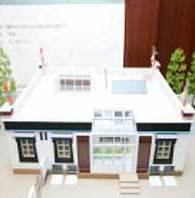Cattle dung has traditionally been a major source of household energy for 55-year-old Yuzhen and her neighbors in the Ralong village, Dingri County, at the foot of Mount Qomolangma.
 |
| File photo:?A solar-based house model in Tibet |
A solar-based house newly built in her village, 40 kilometers away from the base camp of the mountain, however, is poised to provide a new way of living by reducing local residents' dependency on cattle dung for warmth on the Qinghai-Tibetan Plateau.
Every year, Yuzhen's eight-member family burns 300 sacks, or 2,000 kilograms, of dried cattle dung. Half of them are bought from others or at the market.
Sometimes, they collect wood or turf to supplement energy supplies, but the amount is quickly decreasing due to the deteriorating surroundings. Sandstorms, for example, are more frequently seen than before in Yuzhen's village, even in the weather-favorable summer.
Cattle dung is a cheap option, but it contributes to pollution and is not very efficient.
"In winter, the inside temperature drops to below four degrees centigrade at midnight," Yuzhen said.
During the freezing-cold winter, a sound sleep is barely possible, she said. Adding to the woe is the suffocating smog out of the small stove in the living room.
The poor traffic conditions in the region 4,300 meters above sea level make it hard to access petroleum or natural gas that is transferred into Tibet from Golmud, a major city in neighboring Qinghai Province, which is 1,000 kilometers from Lhasa.
Yuzhen's hard times might ease with the construction of a pilot house designed by experts from the China National Engineering Center for Housing Settlements (CNECHS) during their visits to the plateau. The program was part of the Action at the Third Pole of the Earth in late 2008 and early 2009, an annual environment-protection project in China.
Yuzhen's family was selected for the pilot.
According to Zeng Yan, chief architect of Institute of Solar Building Technology under CNECHS, the experimental house built in June is supported by three core techniques: insulation, energy collection and storage.
The 100 square-metre house has an embedded greenhouse that collects the sun's energy, which can be transferred to the surrounding bedrooms and living room by opening connecting windows and doors when the temperature drops in the evening.
"We fully respect the traditional style of architecture of Tibetans," Zeng said. For example, clay bricks were applied as the major construction material instead of concrete.
On top of this, Zeng and his team hoped to improve the layout of Tibetan housing by separating the people and livestock in order to prevent communicable diseases.
Yuzhen and her family are looking forward to the coming of winter, when the new housing will be put to the test.
A preliminary estimate by Zeng and his colleagues finds that the consumption of cattle dung could be potentially halved under the new model and the midnight temperature would be kept at ten degrees centigrade.
It will also be environmentally friendly.
"The emission of greenhouse gases will be substantially reduced, which is important to the protection of the fragile ecology of Mount Qomolangma," Zeng said.
"The design provides a good model for the vast western regions of China," said Xie Yuan, head of Department of Science and Technology of Qinghai Province. In late July, this type of experimental housing was also built around Qinghai Lake in Qinghai.
But this prototype may be unaffordable for many Tibetans, Xie said. The annual personal income in Yuzhen's village is less than 1,700 yuan, but the new house costs nearly 40,000 yuan.
"It will be financially difficult for us to construct this type of house by our own efforts, as we could only rely on our limited farmland to make ends meet," said Yuzhen.
In view of this, the local government is considering appropriating 15,000 to 20,000 yuan for each family to build the new house, said Yang Yan, a program manager from the program's sponsor.
In the initial stage, local Tibebans are encouraged to build houses with financial support from private enterprises like Dupont, said Yang.
Tibet is the richest province in China when it comes to solar energy. The yearly sunshine time surpasses 3,000 hours. There are several small-sized photovoltaic plants in operation, but they have not played a major role for the Tibetans yet because of high costs and maintenance.
The Tibetan pilot house has also led the way in the construction of solar-based houses in China.
In 2007, the Chinese Ministry of Science and Technology launched a project promoting the use of renewable energy into buildings. The target is to save energy equivalent to 220,000 tons of standard coal and 594,000 tons of carbon dioxide per year on new buildings covering 3.2 million square meters by 2012.
(Xinhua News Agency August 5, 2009)